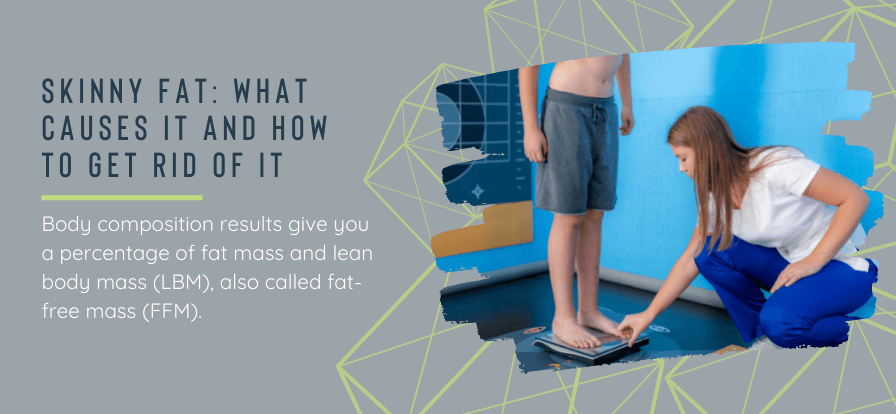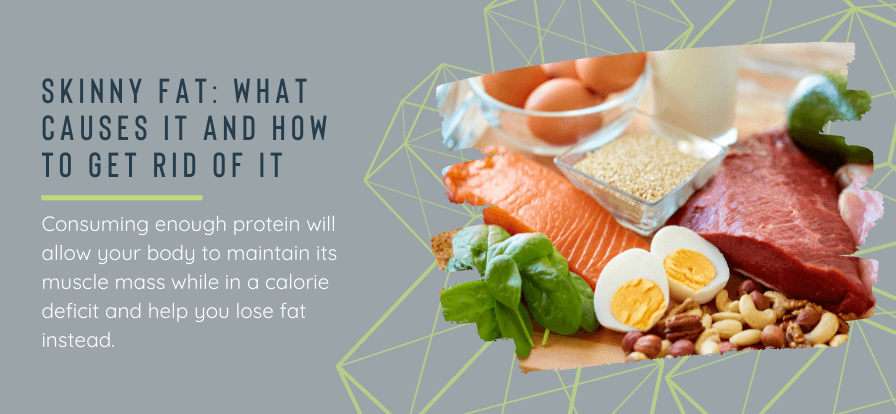Skinny Fat: What Causes It and How To Get Rid of It
Written by Stephanie Hodges, MS in Nutrition and Exercise Science, Edited by Martin Ebner, head Personal trainer and sports nutrition specialist at Ebylife.
We tend to obsess about our weight, but the number on the scale doesn't tell the whole story. A person can be within an ideal weight range, but still be "skinny fat," meaning they have a high percentage of body fat and a low percentage of muscle mass.
Someone in this category may have small muscles and/or a chubby belly, but it isn't all about aesthetics – there are also health dangers that arise from an unhealthy body composition.
The technical term for skinny fat is metabolically unhealthy or metabolically obese normal weight (MONW), which signifies that a person is obese by measure of body composition.
In this article, we're going to discuss body composition, factors that lead to becoming skinny fat, and how to reverse this condition.
What is Body Composition?
Body composition is the ratio of fat to muscle in your body. It's typically measured by taking skinfold measurements or using bioelectrical impedance analysis (BIA). Results give you a percentage of fat mass and lean body mass (LBM), also called fat-free mass (FFM).
Lean body mass includes all the non-fat tissue in your body, such as muscle, bone, water, and organs.
There are two types of body fat: essential fat and storage fat. Essential fat is necessary for survival and is found in the bone marrow, brain, and other organs. Women need more essential fat than men because their bodies naturally store more fat for childbearing.
On the other hand, storage fat is the kind that leads to health problems. This type of fat is found under the skin (subcutaneous) and around the organs (visceral). Too much visceral fat can lead to insulin resistance, a precursor to type II diabetes.
The Dangers of Skinny Fat
While a skinny fat body composition may not seem like a big deal, it can lead to some serious health problems down the road.
Because MONW people have a high percentage of body fat, often stored as visceral fat, and a low percentage of muscle, they are at an increased risk for the following health conditions:
Cardiovascular disease
Metabolic syndrome
Type II diabetes
Non-alcoholic fatty liver disease (NAFLD)
Certain cancers (breast, ovarian, endometrial)
Because visceral fat can lead to insulin resistance, you can also find your body becomes more prone to store fat and you gain more weight over time.
Furthermore, FFM (fat-free mass) is a crucial factor for your Resting Metabolic Rate (RMR), which is how many calories your body burns at rest. So, when you lose weight you want to ensure that you're losing fat and not muscle. Maintaining your FFM helps you preserve a higher metabolic rate.
Finally, without adequate muscle mass and strength, your posture can deteriorate over time, leading to aches, pains and joint issues. Additionally, it can become increasingly difficult to perform everyday activities and maintain your stamina without strong, healthy muscles.
The number on the scale isn't everything; you need to ensure you stay healthy and strong for life!
Related article: How much muscle can you gain in a month?
What Causes Skinny Fat?
Genetics and lifestyle choices both contribute to the size and shape of your body. While you don't have much say over the genes you're born with, you can take responsibility for the lifestyle habits that contribute to becoming skinny fat.
The two most common scenarios that can cause you to find yourself with an unhealthy body composition are:
Sedentary lifestyle and calorie imbalance: If you have a sedentary lifestyle and consume more calories than you burn, the excess calories will be stored as fat. This is especially true if those calories come from processed foods high in sugar and unhealthy fats. As time goes on, your body will get weaker and lose muscle mass, and excess fat will increase.
Overexercising and extreme calorie restriction: On the other hand, if you attempt to lose weight rapidly through severe calorie restriction or regularly perform excessive amounts of cardio, your body may be forced to break down muscle for energy. This will lead to being skinny fat over time as your body loses the ideal ratio of muscle to fat.
This second scenario can be incredibly frustrating for those who are very strict with their diet and exercise regimens but not seeing results. A study in Advances in Nutrition found that normal-weight people who achieved weight loss through a calorie-restricted diet often had fat-free mass loss exceeding 35% of total weight loss. In addition, weight regain promoted more fat gain. You can avoid this scenario with the right healthy diet and lifestyle habits.
If you find that you’ve developed a skinny fat body, the good news is there are simple steps to reverse this condition.
5 Steps to Get Rid of A Skinny Fat Physique
The first step is understanding that body composition is just as important as the number on the scale. So, with that in mind, here are five steps to rid yourself of a skinny fat physique.
1. Commit to a regular strength training routine
Strength training is the essential factor for improving your body composition. It helps to preserve and build muscle while also burning calories and helping you lose fat.
A good strength training program should include a mix of primarily compound exercises that work multiple muscle groups (think squats, deadlifts, presses, and rows) and some isolation exercises that target specific muscles.
If you're not currently performing any strength training, start slowly with two to three sessions per week and focus on learning proper form before adding weight or increasing intensity. It’s important that once you feel comfortable with the lifts to train using the progressive overload principle, which means gradually adding weight, reps, or sets to continue challenging your muscles and stimulating growth.
2. Limit long cardio workouts
Cardio has many health benefits for your heart, lungs, and bones. It's also great for your mental health and improving your sleep patterns, so we're not saying you should avoid it altogether.
But too much of a good thing can be detrimental to your body composition (and cause other issues). When trying to reverse the skinny fat condition, it's best to limit your cardio to the minimum requirements for health and use your exercise sessions to focus on strength training.
Recommendations from the World Health Organization for physical activity are:
150–300 minutes of moderate-intensity aerobic physical activity;
or at least 75–150 minutes of vigorous-intensity aerobic physical activity;
or an equivalent combination of moderate- and vigorous-intensity activity throughout the week
So meeting the minimum requirements could look like 30 minutes five days a week of moderate exercise or 25 minutes three days a week of vigorous exercise.
High-intensity interval training (HIIT) workouts are perfect for meeting the mark for short, vigorous activity workouts.
See Related: HIIT vs Long Distance Cardio for Fat Loss
3. Set a small, sustainable calorie deficit
A sustainable calorie deficit is vital for skinny fat weight loss. A modest calorie deficit will signal your body to release fat stores for energy without breaking down muscle tissue.
You can find your calorie needs by using an online calculator or speaking with a personal trainer or Registered Dietitian. Once you know how many calories you need to maintain your current weight, you can create a deficit by eating less and moving more.
A calorie deficit of 250-500 calories a day will lead to slower weight loss, but at this rate, you can also ensure you're preserving muscle mass and making long-term changes in the way you eat, which will help you maintain your weight loss.
See: Why a slow and steady approach to your health and fitness goals always wins
4. Eat an adequate amount of protein
Protein is the key macronutrient for building muscle tissue. It's also essential for helping your body burn fat. Consuming enough protein will allow your body to maintain its muscle mass while in a calorie deficit and help you lose fat instead.
Research has shown that high protein diets help preserve lean mass. In one study, subjects who ate a high protein (30% of calories) compared to a normal protein (18% of calories) calorie-restricted diet lost less lean body mass and had greater satiety.
How much protein you need depends on your weight, activity level, and goals. When it comes to weight loss and muscle building, it's ideal to consume more than the minimum RDA for protein.
According to the National Academy of Sports Medicine, you should aim for 1.6-2.2 grams of protein per kg body weight while trying to lose weight.
For a 150 lb/68 kg man that means 109-150 grams of protein a day.
See: Protein For Fitness goals: How Much Do You Need?
5. Limit your time being sedentary
Remember that resting metabolic rate we talked about earlier? Sitting all day slows down your metabolism and makes it harder for you to lose weight and keep it off.
NEAT stand for Non-Exercise Activity Thermogenesis and it's the energy you burn during activities of daily living like walking, standing and even fidgeting.
You don't have to go to the gym seven days a week to make a difference. Something as simple as going for a walk after dinner can help you burn extra calories, control your appetite, and improve digestion.
If you have a desk job, try standing up every hour or so and taking a quick lap around the office. You can wear a pedometer or smartwatch and try to meet a goal of 10K steps a day, or a certain number of steps each hour.
Set a goal to move more every day, and you'll start seeing results in no time.
In Summary
Skinny fat isn't a very nice term, but it's important to understand this isn't solely about appearance. Maintaining a healthy body composition is important for many health reasons.
Be sure to increase and maintain your muscle mass through strength training and adequate protein intake, limit excessive cardio, create a proper calorie deficit, and avoid a sedentary lifestyle. These steps will help you avoid the undesirable skinny fat physique and stay healthy for life.




